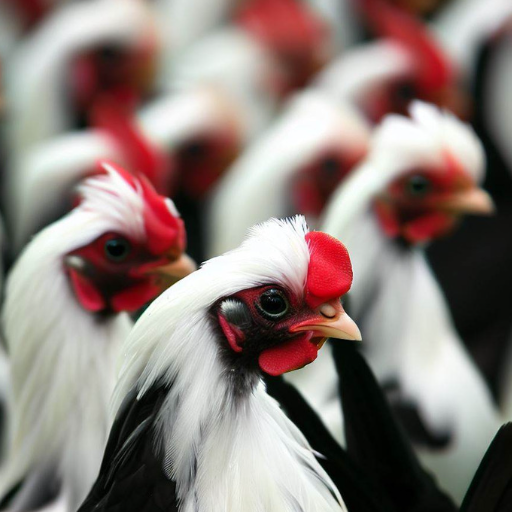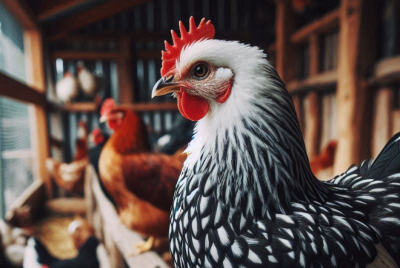From the enchanting land of Japan comes a breed of chickens renowned for their extraordinary size, remarkable strength, and awe-inspiring presence—the Shamo chickens. I’m here to guide you through the captivating journey of raising and appreciating these majestic birds. In this article, I’ll provide helpful suggestions, reasons for my recommendations, and insights into the wonderful world of Shamo chickens.
Introduction
As an enthusiast of Shamo chickens, I have witnessed firsthand the remarkable attributes that set this breed apart from others. Whether you’re a seasoned poultry keeper or someone considering venturing into the realm of chicken keeping, the unique qualities of Shamo chickens make them a captivating and rewarding choice.
History and Background of Shamo Chickens
To truly appreciate the magnificence of Shamo chickens, it’s essential to delve into their rich history and background. Originating from Japan, Shamo chickens have a lineage deeply rooted in the traditions of cockfighting. Their regal appearance and imposing stature reflect their historical role as warriors of the poultry world.
Choosing and Acquiring Shamo Chickens
When embarking on the journey of raising Shamo chickens, it’s crucial to start with healthy and genetically sound individuals. Selecting reputable breeders and acquiring birds with desirable traits will set the foundation for a successful and enjoyable experience. Considerations such as breed purity, breed standards, and the breeder’s reputation should guide your decision.
Housing and Environment
Shamo chickens are known for their impressive size and active nature, necessitating a suitable housing and environment setup. Providing them with a spacious and secure coop is paramount. Ensure ample room for movement, roosting bars at appropriate heights, and sufficient ventilation to promote their well-being. Additionally, incorporating outdoor space for them to explore and forage can enhance their overall happiness.
Feeding and Nutrition
Proper nutrition plays a vital role in the health and development of Shamo chickens. A balanced diet is essential to support their growth, vitality, and overall well-being. When it comes to feeding Shamo chickens, opt for high-quality poultry feed specifically formulated for their nutritional needs. Look for feeds that provide a balanced mix of grains, proteins, vitamins, and minerals.
Supplementing their diet with fresh fruits, vegetables, and herbs can also be beneficial. Not only do these additions provide additional nutrients, but they also contribute to the overall diversity and enrichment of their diet. Offer treats such as mealworms or cooked eggs in moderation to provide extra protein.
It’s important to ensure access to clean and fresh water at all times. Chickens require an adequate amount of water for digestion, egg production, and maintaining proper hydration. Regularly clean and refill their water containers to prevent contamination.
Health and Care
Maintaining the health and well-being of Shamo chickens is crucial for their longevity and quality of life. Regular health checks and preventive care are essential in detecting and addressing any potential issues early on. Here are some key points to consider:
Vaccinations:
Consult with a poultry veterinarian to determine the appropriate vaccination schedule for your Shamo chickens. Vaccinations can protect them against common diseases and promote overall flock health.
Parasite Control:
Implement a
parasite control program to safeguard your chickens from external and internal parasites. Regularly inspect them for signs of mites, lice, or worms, and treat them accordingly.
Hygiene and Cleanliness:
Maintain a clean and hygienic coop environment by regularly removing droppings, providing clean bedding, and ensuring proper ventilation. This helps prevent the spread of diseases and minimizes stress on the birds.
Observation and Early Detection:
Keep a watchful eye on your Shamo chickens for any signs of illness or distress. Monitor their behavior, appetite, and egg-laying patterns. Early detection of any abnormalities allows for prompt intervention and treatment.
Training and Socialization
Shamo chickens possess an innate sense of curiosity and intelligence, making them amenable to training and socialization. By starting early and using positive reinforcement techniques, you can train them to respond to basic commands, recognize their names, or even perform simple tricks.
Socializing Shamo chickens is equally important. By exposing them to various stimuli, interactions with humans, and other chickens, you can help develop their social skills and reduce the likelihood of aggressive behavior. This is particularly important if you plan to keep them in a mixed flock.
Breeding and Reproduction
For those interested in breeding Shamo chickens, understanding the basics of their reproductive cycle and implementing proper breeding practices is key. Consider the following points:
Selective Breeding:
Select breeding pairs that exhibit the desired traits and conform to breed standards. This helps maintain the integrity of the breed and improves the chances of producing offspring with the desired characteristics.
Mating and Incubation:
Allow natural mating to occur or assist in the breeding process. Collect and store fertile eggs carefully, ensuring optimal conditions for successful incubation. Monitor temperature, humidity, and turning frequency during incubation.
Caring for Chicks:
Once the chicks hatch, provide them with a warm and safe brooder environment. Ensure a balanced diet, appropriate heat source, and adequate space for their growth and development. Regularly observe them for any signs of illness or developmental issues.
Showmanship and Exhibition
Shamo chickens have long been admired for their regal appearance and striking presence in poultry shows and exhibitions. To showcase their beauty and appeal to judges, consider the following aspects:
Physical Conditioning:
Maintain their physical health and condition through proper nutrition and regular exercise. Provide opportunities for them to stretch their legs and engage in natural behaviors, such as scratching and dust bathing.
Presentation and Grooming:
Prior to a show or exhibition, give extra attention to grooming your Shamo chickens. Clean their feathers, trim any excess or damaged feathers, and ensure their comb and wattles are vibrant and healthy-looking.
Confidence and Handling:
Familiarize your birds with being handled and examined by gently introducing them to the process. This helps them feel more at ease during the show and allows judges to assess their qualities without stress or resistance.
Posing and Posture:
Practice posing and displaying your Shamo chickens in a way that accentuates their unique attributes. Pay attention to their stance, head position, and overall posture. Showcase their strong build and commanding presence.
Remember, participating in poultry shows and exhibitions is not just about winning awards but also about celebrating the beauty and heritage of Shamo chickens.
Enjoy the experience and take pride in showcasing these remarkable birds.
Flock integration Shamo & Seabright chickens
Step 1: Gradual Introduction
To ensure a smooth integration, I start by gradually introducing the Shamo and Seabright (Sebright) chickens in a controlled environment. This allows them to become familiar with each other’s presence without undue stress or aggression. Careful observation and patience are key during this phase.
Step 2: Secure Separate Spaces
Creating secure separate spaces within the coop or yard is essential for the initial stages of integration. This provides each breed with their own territories and minimizes potential conflicts. By allowing them to establish their individual spaces, I lay the foundation for a peaceful and balanced flock.
Step 3: Visual Contact and Fence Barriers
Next, I enable visual contact between the Shamo and Sebright chickens, using wire fence barriers to maintain a safe separation. This allows them to observe and communicate with each other while preventing direct physical interaction. Building familiarity through visual cues promotes acceptance and reduces the chances of aggression.
Step 4: Controlled Interactions
Once the chickens are comfortable with visual contact, I initiate controlled interactions. This includes supervised free-range time, where they can explore and interact with each other under careful supervision. I watch for any signs of aggression and intervene if necessary to ensure everyone’s safety and well-being.
Step 5: Gradual Coop Integration
After successful interactions, I gradually integrate the Shamo and Sebright chickens within the same coop. This process is done gradually, starting with short periods and gradually increasing the duration. Constant monitoring is crucial during this phase to identify any signs of stress, bullying, or dominance behaviors.
Step 6: Ensuring Resources and Space
Throughout the integration process, I ensure an ample supply of resources such as feed, water, and nesting spaces. Sufficient space allows each breed to establish their territories and reduces the likelihood of competition or aggression over resources. This promotes a balanced and harmonious environment for both the Shamo and Sebright chickens.
Step 7: Patience and Adaptability
Every flock integration is unique, and patience is paramount. I remain adaptable, adjusting my approach based on the individual dynamics and behaviors exhibited by the Shamo and Sebright chickens. By observing their interactions, I gain valuable insights that help me navigate any challenges that arise.
Conclusion
In conclusion, Shamo chickens are truly magnificent creatures that captivate the hearts of poultry enthusiasts around the world. Their rich history, impressive size, and unique traits make them a breed worth considering for both experienced and novice chicken keepers. By following the suggestions and recommendations outlined in this article, you can provide the best care and create a thriving environment for your Shamo chickens. Embrace their warrior spirit and witness the joy they bring to your flock. Ensure you follow the Flock integration guidelines above when considering growing your flock with different breeds.
FAQs
1. Are Shamo chickens aggressive?
While Shamo chickens have a historical background in cockfighting, their aggression levels can vary. Proper socialization, training, and providing a suitable environment can help manage their behavior. It’s important to handle them with care and ensure they are well-socialized from a young age.
2. How big do Shamo chickens get?
They are known for their large size. Males can weigh between 8 to 12 pounds (3.6 to 5.4 kg), while females typically weigh between 6 to 9 pounds (2.7 to 4 kg).
3. Can Shamo chickens be kept with other chicken breeds?
They can coexist with other chicken breeds, but it’s important to consider their size and temperament. Introduce them gradually and monitor their interactions to ensure the well-being of all the chickens in the flock.
4. How many eggs do Shamo chickens lay?
They are not prolific egg layers. On average, they lay around 100 to 150 eggs per year. However, their eggs are often larger than those of other chicken breeds.
5. Can Shamo chickens be raised in urban or suburban areas?
While they require space and benefit from free-ranging, they can adapt to urban or suburban environments if provided with a spacious and secure coop and access to outdoor areas for exercise and foraging.
Remember, raising Shamo chickens is a rewarding experience that requires dedication, patience, and a genuine passion for these magnificent birds. Enjoy the journey of raising and appreciating these awe-inspiring creatures in all their glory.
*We may earn a commission from purchases made through our links, at no cost to you. This does not affect our product recommendations. Please see our disclosure to learn more.




